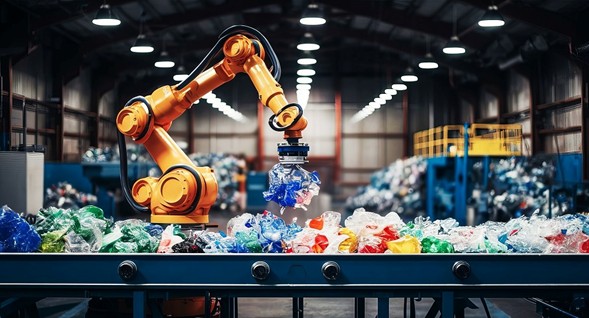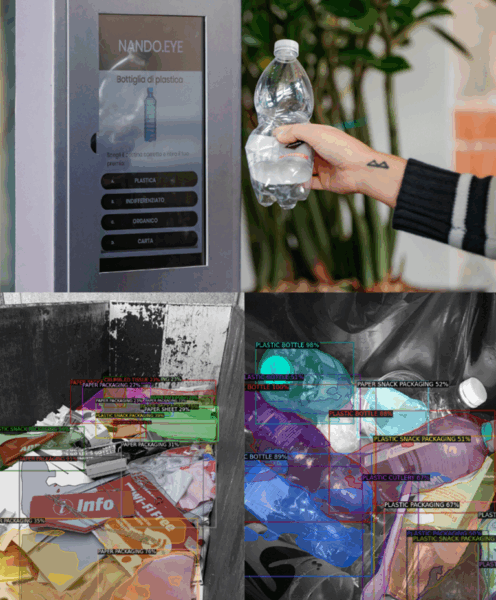Regulatory Frameworks for AI-Powered Plastic Sorting

As artificial intelligence transforms the identification, sorting, and recovery of plastics, regulators are racing to keep pace with a technology poised to redefine the future of recycling.
The global plastic waste crisis is a complex challenge that demands innovative, scalable, and precise solutions. Traditional plastic sorting systems rely on manual labor or sensor-based technologies like near-infrared (NIR) spectroscopy. These systems often struggle with mixed polymers, contamination, and high throughput demands. Artificial Intelligence, combined with machine learning and robotics, transforms this landscape by enabling faster, more accurate plastic identification and separation.
A new regulatory frontier is emerging as these AI-powered systems move from research labs and pilot phases to industrial-scale implementation.
You can also read: Sorting Out the Facts: Bioplastics and Plastic Recycling Can Coexist.
The AI Promise in Plastic Recycling
AI-enabled sorting systems integrate advanced imaging, NIR sensors, and learning algorithms to distinguish between plastic types (e.g., PET, HDPE, PP, PVC, PS), colors, and contaminants. These systems process visual and spectral data to classify materials in real time, adapting to variations in waste composition and environmental conditions. AI-powered sorting systems bring many benefits to plastics recycling. They identify materials more accurately, which helps reduce cross-contamination and raises the purity and market value of recycled plastics. Their speed and real-time decision-making also increase throughput, letting facilities process more waste with greater efficiency. Also, AI can detect tricky materials that older systems often miss, like black plastics, multilayer packaging, and flexible films. These systems also produce detailed data on material types and flow, which helps recycling plants make more intelligent choices about layout, process improvements, and resource use.

NANDO is an AI capable of monitoring waste production to optimize waste management. Courtesy of NANDO.
The Emerging Regulatory Imperative
As the industry adopts AI, regulations must keep pace with the unique nature of these systems. Conventional frameworks for waste management and mechanical equipment do not address AI’s dynamic behavior, reliance on data, or ethical concerns.
Data Governance and Quality Standards
AI sorting systems depend on training data to function correctly. If the data contains bias, lacks key information, or does not reflect real waste streams, system performance can degrade. For example, underrepresentation of flexible plastics or region-specific packaging formats could lead to inaccurate classifications. Standards should ensure that datasets represent the full range of materials, come from ethical sources, and stay securely stored. Guidelines could also define protocols for validating training data and monitoring ongoing data quality. While personal data risks are minimal in this context, transparency in data handling remains important for building public trust in AI applications.
Performance Standards and Verification
Unlike mechanical sorters with fixed specifications, AI systems evolve over time. Their performance can vary based on lighting conditions, material types, or algorithm updates. Verifying these systems under real operating conditions is essential.
Regulatory Need
Standardized test protocols are necessary to measure accuracy, purity rates, throughput, and adaptability. These protocols should reflect real-world waste variability. Regulatory bodies or third-party certifiers may need new capabilities to evaluate AI systems periodically, not just during commissioning.
Interoperability and Standardization
Recycling involves multiple machines and software systems. Lack of interoperability between AI platforms, sensors, and robotic equipment can limit system integration and efficiency.
Promoting open standards for data formats, communication protocols (such as OPC UA or standardized APIs), and modular hardware interfaces would enable plug-and-play compatibility across the recycling value chain. The industry can base these standards on existing industrial automation guidelines to ensure both scalability and vendor neutrality.
Accountability and Liability
If an AI sorting system misidentifies a material, causing process disruptions, safety issues, or poor-quality output, the parties involved must clearly assign responsibility. Without clear liability frameworks, equipment manufacturers, software developers, and plant operators could end up in disputes. AI liability frameworks should clarify roles in system design, integration, operation, and maintenance. This could involve risk-based classification of AI systems (as proposed in the EU Artificial Intelligence Act), combined with requirements for incident reporting, system audits, and human oversight.
Ethical AI and Bias Mitigation
Even in technical fields like recycling, biased AI models can lead to suboptimal performance. For instance, if an algorithm underperforms in recognizing certain packaging formats or waste types common in lower-income regions, it could reduce recovery rates and contribute to material loss. Ethical oversight should ensure that teams regularly evaluate AI models to maintain consistent performance across diverse waste streams. Developers may need to document algorithm development, perform bias testing, and provide explainability tools for facility operators.
Unlocking AI’s Full Potential
Developing clear regulations for AI in plastic recycling is challenging but essential. It requires strong teamwork between recyclers, equipment makers, AI developers, and regulators.
Several global initiatives provide blueprints. For instance, the European Commission’s Digital Product Passport concept could complement AI traceability in recycling systems. ISO and IEC are also developing standards related to AI performance, safety, and transparency. National recycling authorities can build on these frameworks to support safe deployment and innovation.
With the right regulatory support, AI can dramatically improve plastics recycling by increasing material recovery, enhancing quality, and reducing system costs. It can also help meet broader policy goals, such as reducing landfill use, supporting circular economy targets, and cutting greenhouse gas emissions. But to achieve this, AI demands responsible design, oversight, and continuous improvement.
